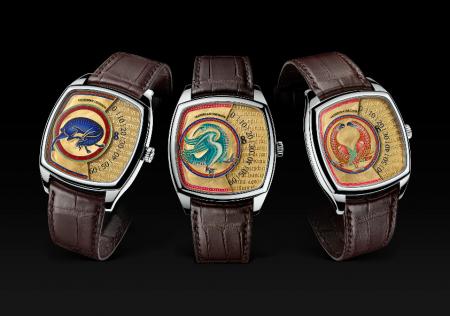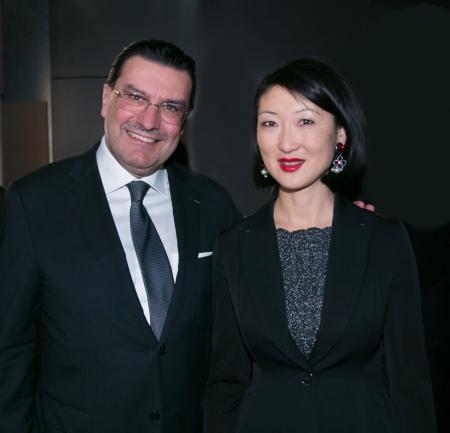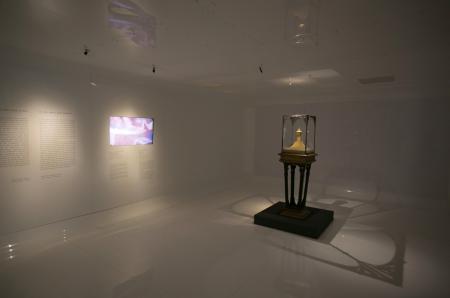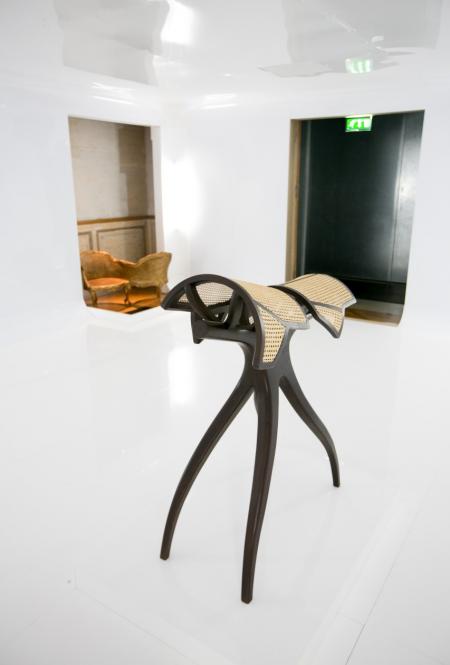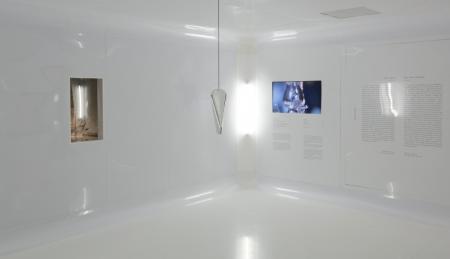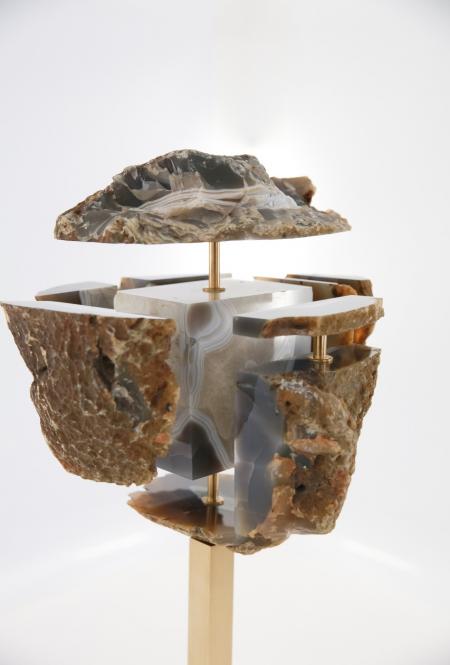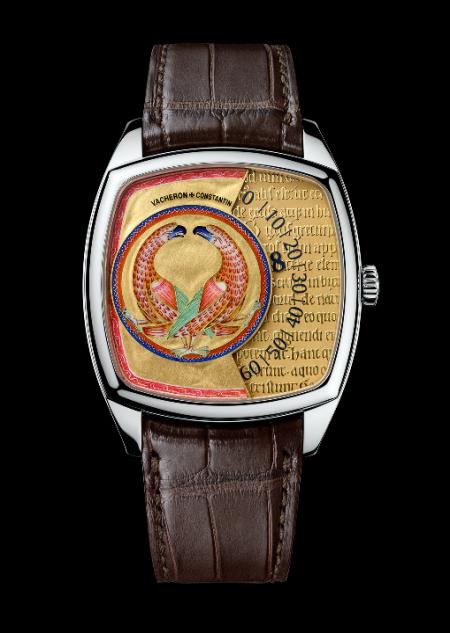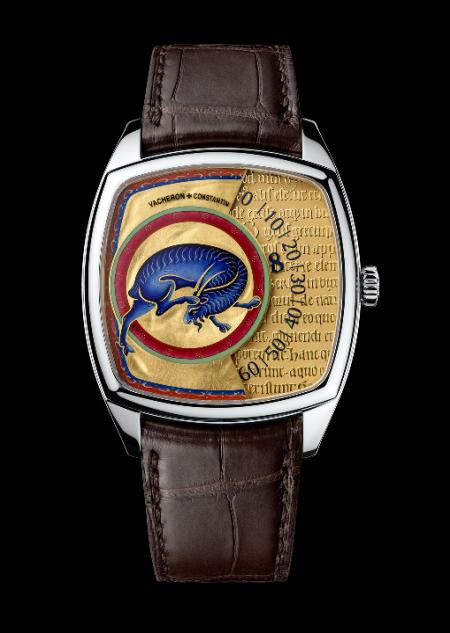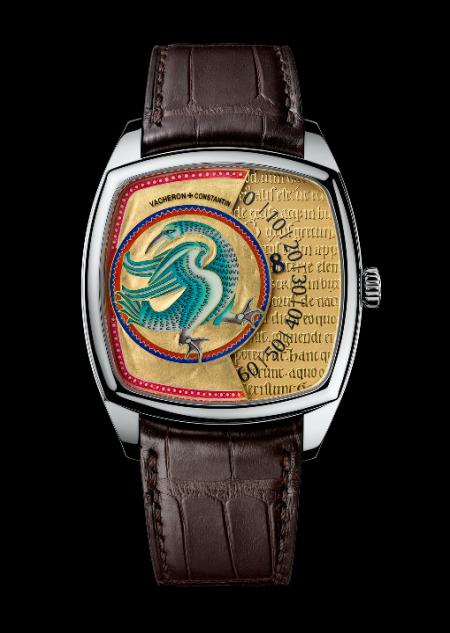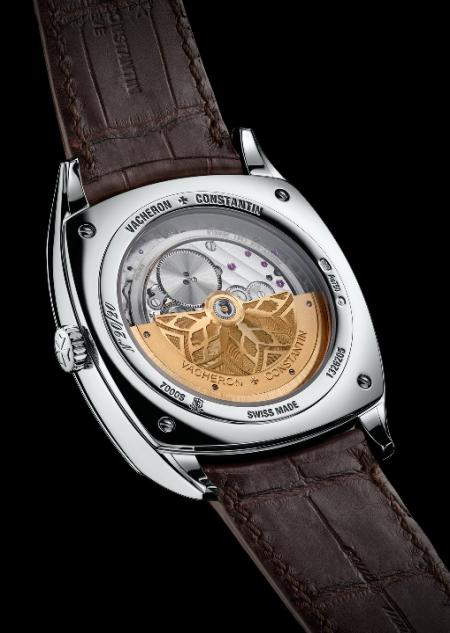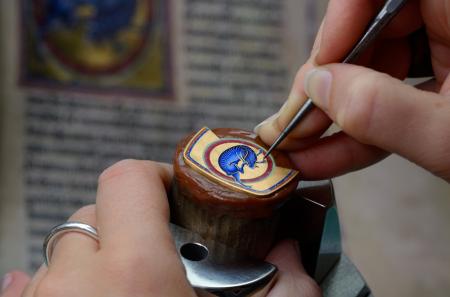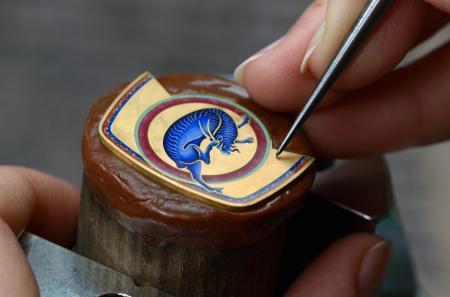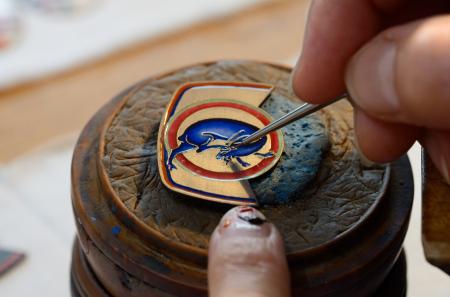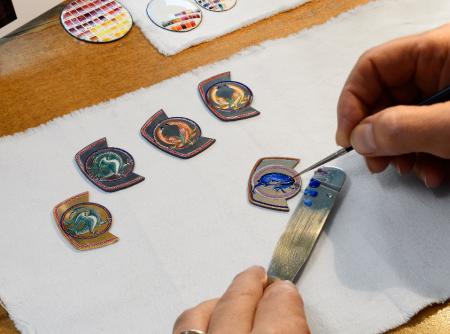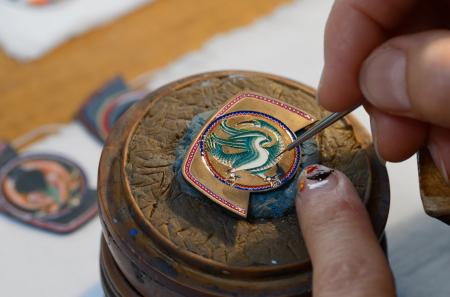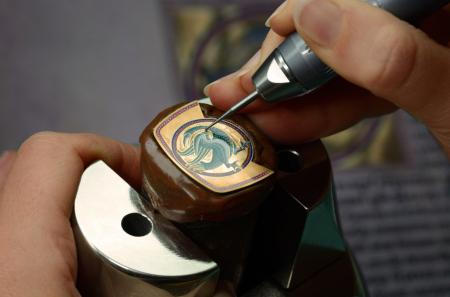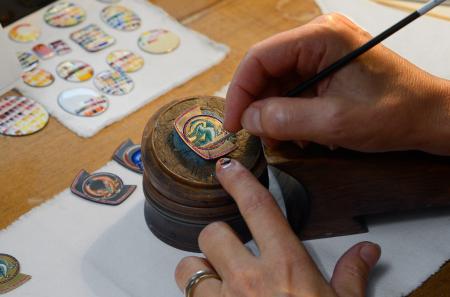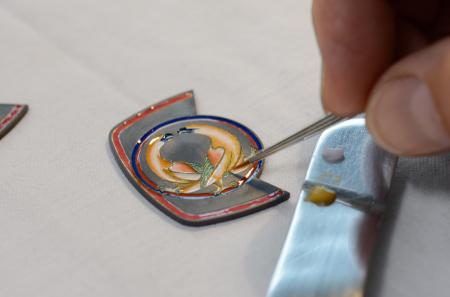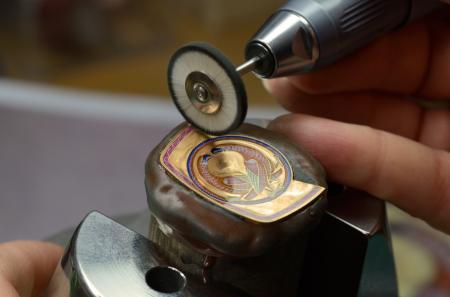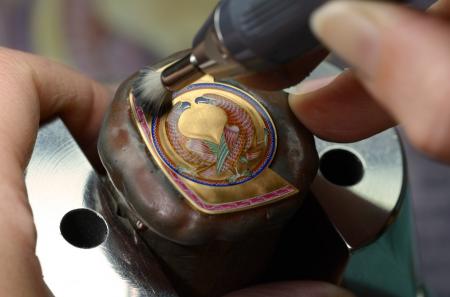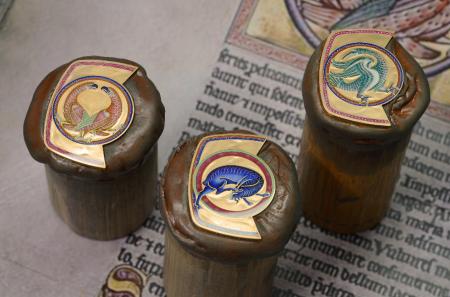Vacheron Constantin affirms its attachment to Craftsmanship
Thursday, March 26, at the launch of the “Journées Européennes des Métiers d’Art” (JEMA), Vacheron Constantin presented the exhibition “Mutations” at the “Musée des Arts Décoratifs” in Paris in partnership with the “Institut National des Métiers d’Art” (INMA).
The opening was attended by Fleur Pellerin, Minister of Culture and Communication and was attended by Juan Carlos Torres, CEO of Vacheron Constantin, Desquand Gerard, president of the National Institute of Trades Art, Bruno Roger, President of Decorative Arts and Serge Nicole, President of Ateliers d’Art de France.
From a selection of iconic objects from the museum, the collective of artists and artisans have worked to revisit their technical repertoire of forms and materials to create a specific work. The exhibition “Mutations”, presented until July 5, 2015, puts into perspective born nine objects of this project exposed face of the historical pieces that have inspired.
After the opening, guests also had the opportunity to discover in preview the new collection Métiers d’Art of the watch manufacturer, “Savoirs Enluminés”, inspired by illuminations of Aberdeen Bestiary. It perfectly illustrates the joint work of Vacheron Constantin artisans, whose talents come together and combine to give birth to “Métiers d’Art” exceptional dials.
Exhibition “Mutations”
Until July 5
Musée des Arts Décoratifs
107 rue de Rivoli, Paris
VACHERON CONSTANTIN
MÉTIERS D’ART SAVOIRS ENLUMINÉS
Magnified by Time : Medieval Illuminations Embody Works of Art that are Rich in Meaning
The passing of the centuries has in no way dulled Vacheron Constantin’s boldness nor its quest for excellence. Now more than ever, the Maison asserts its creativity and skills in the realm of artistic crafts. With Savoirs Enluminés, a 60-piece limited series, Vacheron Constantin takes us on a voyage of discovery to the very heart of the Middle Ages, of illuminated manuscripts and the transmission of knowledge. Savoirs Enluminés is an exceptional collection that highlights watchmaking expertise, notably due to the original hour display on its ultra-thin self-winding calibre, as well as great mastery of the decorative arts.
Decorative watchmaking offers an opportunity to give free rein to artists’ unbridled imagination, while developing innovative craft techniques. Vacheron Constantin has always displayed a unique inclination towards art and cultural patronage and draws upon these riches in the exceptional limited edition Savoirs Enluminés timepiece collection, which demonstrates Vacheron Constantin’s genuine technical and aesthetic expertise.
The new Métiers d’Art Savoirs Enluminés collection draws aesthetic inspiration from the Aberdeen Bestiary, an ancient Celtic manuscript recovered from the Middle Ages that is internationally recognised for the quality of its miniaturized illuminations. The art of miniaturisation, designed to emphatically celebrate a sizeable body of handwritten literature, is a complex technique requiring extensive collaboration between scribes, painters and gilders in the creation of veritable works of art. Its natural affinities with the world of watchmaking are particularly apparent in the new Métiers d’Art Savoirs Enluminés collection. Over and above the exceptional beauty of the Aberdeen Bestiary, Vacheron Constantin pays tribute to the transmission of knowledge that these manuscripts symbolize. An adventure that leads us to encounter a veritable legend, all too rarely revealed to the public, and yet almost universally shared by Eastern and Western cultures.
Aside from the exceptional aesthetic aspects of the Métiers d’Art Savoirs Enluminés timepieces, the collection also offers a patented mechanism featuring a dragging (or trailing) hour display. Combined with the delicate craft of Grand Feu enamel, which includes the Genevan technique of miniature painting, this limited edition timepiece collection contains is truly exceptional.
A medieval vision of the world according to the Aberdeen Bestiary
The Aberdeen Bestiary was commissioned in the 12th century. This “book of beasts”, conveying a wide range of knowledge and beliefs, is filled with information that is key to understanding the evolution of humankind while exalting the power of metaphor. In the Middle Ages, this rhetorical procedure was very common and the symbolic role of the animal was credited with human feelings and character traits. The animal did not exist for what it was, but rather to represent the wonders of Creation. It taught knowledge, but above all transmitted moral precepts. Animals were variously used to convey dreams, conquests or power, and regularly appeared in fables and satirical novels. The art of illustration was an integral part of this educational vocation. The creatures represented in a figurative painting style with great colour intensity and highly detailed drawings often feature fantastical attributes resulting in a strikingly modern graphic appearance.
The art of combining talents… through the centuries and the arts
The extremely high-quality illuminations in the Aberdeen Bestiary are painted on a gold background, barely burnished by time. They reveal colours, mainly blues and pinks and which remain extremely intense, with white having been used to accentuate the curves and shapes of the bodies. The artists required enormous imagination to draw these incredible animals that they had never seen…
Over and above their undeniable cultural value, the miniatures found in the Aberdeen Bestiary are a perfect example of a combination of talent. The illuminator and the gilder succeeded in perfectly matching their actions on the 103 folios of which the work consists. Like watchmaking, the manuscripts of the era passed through the hands of several master craftsmen and, step by step, each artisan made an essential contribution to the composition. On a parchment prepared by hand, the copyist monks hand inscribed the body of the text, leaving space with indications regarding the application of the gilding and the illuminations intended to structure the body of the text. Following this, the gilder applied the gold leaf. Finally the illuminator created his miniature directly on the fine layer of gold including the sketch, mixing of natural pigments and colouring by layer – an art requiring both coordination and precision.
Similarly, the Métiers d’Art Savoirs Enluminés collection contributes to perpetuating this mind-set through timepieces that embody Art born of the collaboration between master craftsmen.
Creation, a multi-faceted, universal language
Marrying original watchmaking techniques and skilled artistic crafts in the Métiers d’Art Savoirs Enluminés collection, Vacheron Constantin pays homage to the art of miniature through superb enamelled reinterpretations. Ancient illuminators worked according to standards that are identical to those of enamellers, with the same actions that imbue a precious object with an emotional language that is both manifold and universal. To achieve a piece that emanates true intensity, the artisans must first perfectly understand the possibilities and constraints of each technique. Their inspiration is nourished by influences and experiences. Only in this way will they be able to give the best of themselves and offer true authenticity.
Métiers d’Art Savoirs Enluminés
The Métiers d’Art Savoirs Enluminés collection comprises three 20-piece limited edition timepieces, each illustrated with an animal from the Aberdeen Bestiary.
The first of this trio is the “Altion”, a beautiful seabird linked to Water, building its nest on the seas, no matter what the weather, and symbolising serenity (an extract from folio 54v). The care given to its blue green plumage, the elegance of its wings and the flexibility of its posture perfectly fit the circular shape of the dial. The second model, “Vultures”, is adorned with two fowl back to back – the quintessential ambassadors of the Skies, casting a knowing glance (extract from folio 44v). Against a graded pink background, their bodies form a circle, the symbol of infinity and longevity. The third model, “Caper” – is devoted to the Earth (extract from folio 14r). It presents a midnight blue goat with a piercing gaze, and endowed with exceptionally sound judgement.
These three creatures are illustrated in a representation that is extremely true to the original illuminations. Each project involves its own set of considerations, as well as surprises and wonders. In these models, Vacheron Constantin has chosen to call on traditional decorative techniques: the art of Grand Feu enamel reminiscent of illumination, engraving as a nod to calligraphy, along with a delicate phase of shadowing and gold texturization in order to create the effect of gold leaf.
A layered dial, an artistic vision of time
Every gesture made by the craftsman who worked on Savoirs Enluminés is part of a smoothly continuous sequence and each is dependent on the other. The end result remains unpredictable right up to the final touch, the casing-up. The complexity of these timepieces can be seen at first glance through a twin-level 22-carat gold dial. The upper element, bordered by a frieze, has a fantastic creature in its centre. Adorned with Grand Feu enamel, the upper dial perfectly marries miniature and champlevé techniques. The task of enamelling is long and labour-intensive, with colours applied through a microscope, one after the other, before several stages in the kiln, while remaining as true to the original as possible. In the background, the enamelled gold background is magnificently textured by hand with the help of fine brushes and erasers in order to emulate the gold leaf effect as closely as possible. And, as is always the case, the unexpected can occur at any time, and enamel remains a fragile, capricious art, but the luminous result is there for all to admire.
The dial’s upper level opens on the right, revealing the lower part. There are traces of a Latin text from the Aberdeen Bestiary manuscript. This is a tribute to the creative power of Nature (Natura) and Life (Vita). This miniscule piece of gold is structured over three levels of detail, none of which are thicker than 0.9 mm. The raised, polished letters contrast with the finely grained background, while the Arabic numerals on the chapter ring, arranged in a semi-circle, are delicately painted on the upper surface. Finally, between these two levels on the dial, the hour numbers slide from top to bottom, in turn, in 60 minutes. The effect is truly striking! The light reveals a subtly balanced association of matt and polished finishes. This exemplifies truly outstanding craftsmanship in the domain of miniaturisation.
An equally fabulous mechanism on which hours glide by much as as the eye glides over a page
Savoirs Enluminés’ astonishing dial display is made possible by an exclusive mechanism: self-winding Caliber 1120 AT, built an ultra-thin base movement. Developed and crafted by Vacheron Constantin entirely in keeping with the traditions of haute horlogerie, it meets the Hallmark of Geneva criteria that are no longer confined to the movement alone, but also take into account the complete watch. It beats at a frequency of 2.75 Hz (19,800 vibrations/hour) and has an approximately 40-hour power reserve. Its finishing and its construction testify to fine workmanship taken to extremes. Not only are the main flat movement surfaces adorned with a meticulous Côtes de Genève pattern, but all their sharp angles are also finely chamfered and hand-polished. The same applies to the screw heads.
The dragging or trailing display was designed and developed by the Vacheron Constantin engineers. The three spokes of the hours wheel are prolonged by a carousel. Each bears four hours numerals, whose direction is determined by a cam shaped like a Maltese Cross – a patented mechanism echoing the brand emblem. The hours crown (wheel) turns in such a way as to successively place the carousel bearing the appropriate numeral opposite the corresponding minutes painted on the lower dial. The hour slides gradually downwards, before vanishing after crossing the 60-minute mark. It thus makes way for the numeral of the following hour. In this airy display, time seems to glide across this work just as the eye glides across the page of a book. The effect is evocative, unexpected, and gently poetic.
This successful demonstration of Vacheron Constantin’s mechanical genius is protected by a broad 18-carat gold shaped case. The name of the animal portrayed on the dial is faithfully engraved along the side exactly accordance with the original script. Finally, the transparent case-back is protected by a sapphire crystal affording a chance to admire the qualities of the self-winding movement, as well as its gold oscillating weight with a tapestry-like motif. The latter is a stylised depiction of the neo-gothic architecture of the arches on the Crown Tower of King’s College, Aberdeen University. The tapestry work, a decorative style inspired by guilloché (engine turning) is made using an over century-old tool operating according to the same principle as the pantograph. This technique requires extremely fine adjustment and must be adapted to each new oscillating weight, while providing a magnificent opportunity to create raised and hollowed areas measuring barely a tenth-of-a-millimetre and resembling embroidery work. Métiers d’Art Savoirs Enluminés is the epitome of exquisite refinement.
Custodian of a precious body of expertise, Vacheron Constantin, the oldest watch manufacturer in continuous activity since its founding in 1755, proudly embraces its watchmaking history with the satisfaction of revealing arts displayed in authentic treasures of Humanity like the Aberdeen Bestiary. The Savoirs Enluminés collection will undoubtedly delight the aesthetes among us, without neglecting devotees of technical sophistication.
A detailed account of the Aberdeen Bestiary
The Aberdeen Bestiary was initially listed in 1542, during an inventory of the Old Royal Library in Westminster Palace. It was however written and illuminated long before, in around 1200. Aside from the beauty of its illuminations, it reveals all the uniqueness of medieval thinking, characterised by this highly categorised approach of the fear of the world. A means of arranging knowledge that is also found in other cultures of the time, notably in the Middle East and the Far East, and which strives to formulate factual descriptions through a symbolic, moralist approach applied in a systematic manner. An understanding shared by everyone, clearly inspired by the Physiologus, a Greek text dating from the 11th century found in Alexandria, and founder of many encyclopaedic manuscripts all over the world.
The Aberdeen Bestiary is arranged on a hierarchical basis in 11 chapters: the creation of the world, wild animals, domestic animals, small animals, birds, snakes and reptiles, worms, fish, trees and plants, human nature and finally, minerals. Today it is preciously kept in the library of the University of Aberdeen in Scotland. This extremely rare object has only been exhibited to the public on one occasion, in 2012, during the inauguration of the new library at the University of Aberdeen. In order to remain preciously preserved from light and damp, it can only be observed for 30 minutes a day.
Latin text from the Aberdeen Bestiary (folios 80 & 81) adorning the lower dial.
“Natura dicta eo quod nasci aliquid faciat, gignendi enim et faciendi potens est. Vita dicta propter vigo rem vel quod vim teneat nascendi atque crescendo”
English translation
Nature, natura, is so called because it brings a thing to birth, nasci for it has the power to beget and to form. Life, vita, is so called from vigor, ‘active power’, because it has within it the force of birth and growth.
Disclosure of knowledge through the Fundamental Manuscripts
The art of illustrated bestiary appears through cultures and different eras and always with the same thread running through it – namely to combine the science-based written word with richly painted illustrations. Amongst the most emblematic encyclopaedic manuscripts that must be mentioned is the Manafi’Al-Hayawan (The Benefits of Animals), a Persian manuscript dating back to 1297 and kept at the Morgan Library in New York.
In Asia, Chinese encyclopaedias – leishu – instruments created to promote the transmission of knowledge and education, appeared from the beginning of the 3rd century already. The Dunhuan, rediscovered at the beginning of the 20th century in the Mogao Caves in northwest China, in the heart of the silk route, involves 5000 rolls of silk dating from the 5th to the 11th century. This is a key source of information on the history of Chinese culture. The same applies to the monumental Yongle Dadian, a veritable compilation of knowledge from the era, written under the Ming dynasty from 1403. This was the biggest encyclopaedia in the world at that time, consisting of 28,877 chapters bound in 11,095 volumes, or around 50 million Chinese characters! Each one is testimony to a certain vision of Humanity, always following the same logic of disclosing a certain moral vision.
